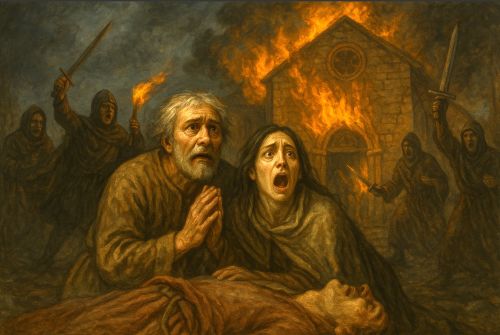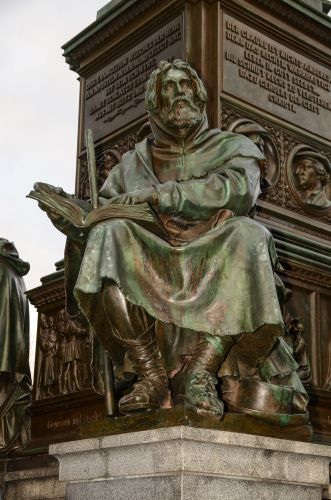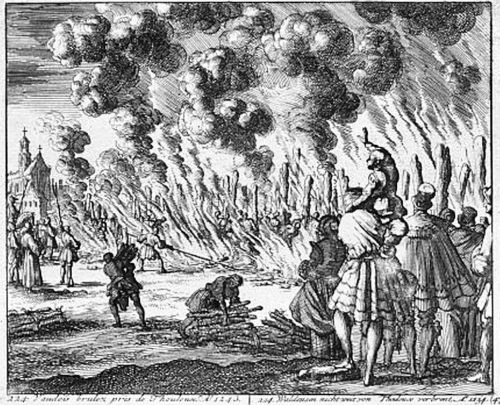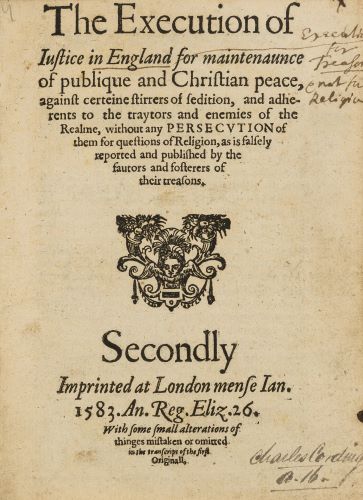

The Waldensian story remains a mirror for every age in which conviction eclipses truth. When belief becomes an instrument of domination, rumor becomes revelation and justice decays into spectacle.

By Matthew A. McIntosh
Public Historian
Brewminate
Introduction
In the twelfth century, a merchant from Lyon named Peter Waldo renounced his wealth and devoted himself to a life of evangelical poverty, preaching the Gospels in the vernacular so that ordinary people might know the Word without clerical mediation. His followers, soon known as the Waldensians, sought not to rebel against the Church but to revive what they saw as its original simplicity: a faith stripped of opulence, hierarchy, and corruption. Their lay preaching and insistence on scriptural authority challenged no doctrine of the Creed, yet they defied the monopoly of clerical power, and therein lay their danger. What began as a call for reform was rebranded by the Church as heresy, a deliberate reimagining of faith as rebellion.
The Waldensians’ transformation from reformers to heretics was not born of theology but of fear. By translating scripture into the language of the people and rejecting the wealth of prelates, they undermined both the economic and symbolic order of medieval Christendom. Papal decrees such as Ad abolendam (1184) institutionalized suspicion of unsanctioned preaching, and Church authorities learned to wield accusation as a weapon. Rumor became doctrine; heresy became policy. Across the thirteenth and fourteenth centuries, inquisitors and bishops refined a machinery of suppression that equated dissent with moral contagion, constructing heretics as diseased bodies in need of purification through fire and sword.
By the sixteenth century, this logic of extermination had reached its most devastating form. In 1545, the Waldensians of Provence, descendants of the same movement that had preached humility three centuries earlier, were massacred in their villages of Mérindol and Cabrières after Church and crown spread claims of armed rebellion. Entire communities were destroyed on the pretext of heresy and treason, their lands confiscated and their people slaughtered. The episode epitomized the lethal fusion of rumor and power that had long characterized ecclesiastical persecution. The truth of their faith was silenced beneath centuries of invention.
The story of the Waldensians is not simply one of belief, but of the corruption of belief—how institutions can weaponize faith to annihilate those who most sincerely embody it. Their massacre stands as a monument to the peril of conviction unmoored from evidence, when unexamined rumor becomes revelation and violence masquerades as righteousness. In that crucible of persecution, the medieval Church revealed not the strength of its faith, but the fragility of its conscience.
Origins of the Waldensian Heresy: Gospel Poverty and Ecclesiastical Fear

When Peter Waldo began preaching in Lyon during the 1170s, his message was disarmingly simple: the Gospels called for a life of voluntary poverty, humility, and imitation of Christ. He commissioned translations of scripture into Provençal so that the laity could understand the teachings without priestly mediation. What he proposed was not rebellion but renewal, a call for spiritual authenticity within the Church itself. Yet this act, however pious, destabilized an institution already anxious about maintaining control over salvation and interpretation. In an era defined by papal centralization and reform, Waldo’s decision to empower ordinary believers threatened the monopoly of clerical authority more profoundly than open defiance ever could.1
The Third Lateran Council of 1179 offered a brief moment of tolerance, acknowledging the sincerity of Waldo’s intentions but ordering him to cease preaching without episcopal approval. His refusal marked the turning point from reformer to heretic. In 1184, Pope Lucius III issued Ad abolendam, a decree that formally condemned the Waldensians alongside Cathars and other groups deemed subversive to Church unity.2 Heresy, in the late twelfth century, had become not simply a matter of doctrinal deviation but a political offense, a rupture of the Church’s social fabric. To defy its authority, even out of conscience, was to threaten the coherence of Christian society itself.3
The Church’s fear of lay preaching reflected a broader anxiety about knowledge and control. The Waldensians’ vernacular sermons made the sacred accessible to all, undermining the linguistic and intellectual monopoly of the Latin clergy. Ecclesiastical writers such as Alain of Lille and Walter Map portrayed Waldo’s followers as presumptuous, ignorant, and spiritually reckless, painting their enthusiasm as arrogance rather than piety.4 This rhetorical inversion transformed virtue into vice: poverty became insolence, sincerity became subversion. By defining orthodoxy as obedience, the Church ensured that dissent, however faithful, could be branded as rebellion.
The label of heresy thus emerged less from theological disagreement than from institutional necessity. The Waldensians’ insistence on moral reform challenged the hierarchy’s legitimacy at a time when papal supremacy was consolidating across Europe. Their condemnation was as much an act of self-preservation as of doctrine. In suppressing them, the Church defined its own boundaries, establishing the precedent that to preach without sanction was to defy God Himself. What began as an earnest movement of conscience would, over centuries, become the pretext for one of the most enduring persecutions in Christian history.5
Constructing the Enemy: Heresy, Rumor, and Social Control

To the medieval Church, heresy was never a neutral category of belief, it was a narrative weapon. Once Peter Waldo’s movement had been classified as heretical, the Church’s project shifted from correction to containment. Ecclesiastical authorities began constructing an image of the Waldensians not merely as errant Christians but as an existential threat to Christendom itself. Theological rhetoric merged with political propaganda to present heresy as contagion: an infection of body and soul that demanded eradication before it spread.6 This metaphor transformed dissent into disease, turning spiritual reformers into enemies of social order. It was within this discursive framework that the Waldensians’ moral challenge became grounds for annihilation.
The Inquisition, institutionalized during the thirteenth century, became the instrument by which this fear was codified. Inquisitors were trained to identify heresy through patterns of rumor, confession, and association rather than theological proof.7 Manuals such as Bernard Gui’s Directorium inquisitorum instructed officials to interpret secrecy, poverty, or unusual devotion as signs of heterodoxy, effectively criminalizing humility itself.8 The process privileged suspicion over evidence; guilt was inferred from demeanor rather than doctrine. In this way, inquisitorial language created its own self-validating cycle of persecution: the more the accused protested innocence, the more their resistance was framed as deception. The result was a bureaucratic theology of fear, where rumor assumed the weight of revelation.
Secular elites also found utility in this evolving narrative. Labeling subjects as heretics provided both moral justification and legal pretext for confiscation of property and consolidation of local power.9 In Provence, Dauphiné, and Lombardy, bishops and nobles alike collaborated to exploit inquisitorial accusations for material gain. Heresy trials blurred the line between spiritual discipline and political opportunism, transforming orthodoxy into an instrument of economic control. As the historian Marina Benedetti observes, the Waldensians’ persecution became a form of “administrative expropriation,” legitimized through the language of faith.10 The machinery of rumor thus served both pulpit and purse.
Meanwhile, ecclesiastical chroniclers amplified the image of Waldensians as morally deviant, accusing them of nocturnal assemblies, sexual licentiousness, and blasphemy.11 Such stories, devoid of evidence, circulated widely in sermons and popular tales, feeding a collective imagination of danger. The logic was simple: by painting heretics as monstrous, the Church could frame violence as purification. These narratives erased individuality, transforming believers into archetypes of evil. Fear replaced understanding, and the spectacle of execution reaffirmed divine order before a watching crowd. It was propaganda not merely told but performed.
By the fourteenth century, this synthesis of rumor, theology, and coercion had matured into a durable social technology. Heresy served as the mirror in which Christian society defined its boundaries, projecting its own anxieties onto those it destroyed. The Waldensians, once preachers of the Gospel, had become symbols of contamination within a moral economy that demanded constant purification. Their extermination was justified not by what they believed, but by what others were made to believe about them. In that inversion lay the genius, and the horror, of medieval social control.
The 1545 Provence Campaign: Political Greed and Manufactured Treason

By the sixteenth century, the Waldensians had endured centuries of repression and dispersion, surviving largely in remote Alpine valleys and small communities across Dauphiné and Provence. Their persistence (rooted in simplicity, communal worship, and biblical literacy) was both a testament to faith and an irritation to power. France under King Francis I had entered an uneasy balance between tolerance and suppression, yet that balance fractured under the pressure of rumor. In 1545, unfounded reports began circulating that the Waldensians of Mérindol and Cabrières were secretly arming for rebellion.12 These rumors, fostered by clerical officials and local magnates, provided the pretext for a campaign of annihilation masquerading as royal justice.
The events were precipitated by a royal decree issued in 1540 that ordered the destruction of Waldensian villages in the region, a sentence initially suspended through the intervention of humanist sympathizers at court.13 But as Reformation tensions deepened and the Church’s patience waned, the Parlement of Aix revived the decree. In March 1545, Jean Maynier d’Oppède, First President of the Parlement, led royal and papal troops into the valleys of the Luberon. His orders framed the mission as the suppression of sedition, not the extermination of heretics, yet the soldiers understood otherwise.14 Over the following weeks, entire communities were burned, thousands were killed or enslaved, and property was seized under the sanction of both cross and crown. The moral vocabulary of rebellion had become the legal language of genocide.
The campaign’s justifications reveal the cynical fusion of political greed and theological manipulation. Local officials spread tales that the Waldensians rejected royal authority, held secret councils of war, and sought alliances with Protestant reformers abroad.15 No credible evidence of any armed uprising was ever found. The lie served a dual purpose: it satisfied ecclesiastical zeal for orthodoxy while enabling regional elites to claim confiscated lands. The chronicler Jean Léger, writing a century later from surviving documents and eyewitness testimony, recorded how priests blessed troops before slaughter and claimed divine sanction for every act of cruelty.16 The supposed defenders of faith had become instruments of plunder.
Beyond the immediate violence lay the machinery of rumor that made it possible. Correspondence from Guillaume du Bellay, a French diplomat and moderate Catholic, laments how the “monstrous fables” against the Waldensians were repeated in pulpits and courts until even the indifferent believed them.17 Once public imagination had been captured, reason no longer mattered. The massacre was not the result of collective hysteria alone; it was carefully engineered by those who understood how easily fear could masquerade as virtue. The Church’s rhetoric of spiritual warfare offered absolution in advance.
In the ashes of Mérindol and Cabrières, truth had no place. Survivors fled into the Alps, carrying only fragments of their scriptures and the memory of betrayal. For the Church, the massacre was a triumph of orthodoxy; for the victims, it was the culmination of centuries of defamation. The Waldensians’ destruction in Provence stands as one of the earliest modern instances of state-backed extermination justified by religious rumor. It demonstrated that in the politics of persecution, lies were not aberrations but strategy, the indispensable foundation of righteous violence.18
The Piedmont Easter Massacre (1655): From Rumor to Extermination

A century after the devastation in Provence, the Waldensians again faced annihilation, this time in their ancestral valleys of Piedmont. In 1655, under the rule of the Duke of Savoy, an old alliance between Church and state revived the language of rumor to prepare the ground for another purge.19 The Waldensians, now a small but enduring Protestant minority, had signed agreements promising loyalty to the Duke in exchange for limited freedom of worship. Yet in the shadow of the Counter-Reformation, these promises became untenable. Papal envoys denounced the Waldensians as obstinate heretics who secretly plotted rebellion, reviving once more the trope of armed sedition.20 The charge was unfounded, but it furnished the moral pretext for military invasion.
In April 1655, Holy Week, the Duke’s troops entered the valleys under the guise of enforcing order. Within days, the campaign descended into massacre.21 Villages such as La Torre, Bobbio, and Villar were burned to the ground. Contemporary reports describe soldiers mutilating corpses, burning families alive in barns, and forcing survivors into the mountains where many died of exposure.22 The papal nuncio’s correspondence, preserved in the Archivio Segreto Vaticano, celebrated the “cleansing of heresy” as a triumph of divine will. The same language that had sanctified the destruction of Mérindol a century earlier was now deployed again, proof that rumor, once institutionalized, outlived its inventors.
The massacre drew immediate international condemnation, especially among Protestant states. Oliver Cromwell, then Lord Protector of England, ordered a national day of fasting and raised funds for survivors.23 The poet John Milton immortalized the event in his sonnet “On the Late Massacre in Piedmont,” transforming outrage into memorial. Yet beyond its literary resonance, the response revealed the emerging tension between a European conscience awakened to atrocity and the old logic of clerical impunity. For the first time, the Waldensians’ persecution entered the public consciousness of Europe not as heresy punished but as evil justified by deceit. Their suffering forced the moral question of how truth could exist in a world where belief itself was manufactured.
Though the violence eventually subsided under diplomatic pressure from England and the Dutch Republic, its effects were permanent.24 Entire communities had been erased, their churches desecrated, their lands divided among collaborators. In the aftermath, surviving Waldensians rebuilt with extraordinary resilience, forming the first organized Protestant missions in continental Europe. Their endurance exposed the moral bankruptcy of their persecutors, revealing that what the Church had called purification was, in truth, fear institutionalized. The Piedmont Easter Massacre was not an aberration of faith but its corruption, a final act in a centuries-long tragedy where rumor once again triumphed over reason, and piety was extinguished in the service of power.
Memory, Martyrdom, and the Politics of Truth

In the aftermath of centuries of persecution, the Waldensians began to reconstruct their history not merely as survival but as testimony.25 Their collective memory transformed atrocity into narrative, an act of resistance against the lies that had justified their suffering. Manuscripts preserved in the valleys of Angrogna and Torre Pellice record sermons and letters written by elders who sought to preserve the truth of their faith for future generations.26 These texts framed martyrdom not as defeat but as vindication: proof that truth could be suppressed but never extinguished. In a Europe still ruled by confessional boundaries, memory itself became their sanctuary, a space where they could reclaim moral authority from those who had persecuted them.
This reclamation of truth found expression in Protestant martyrologies such as John Foxe’s Acts and Monuments, which recast the Waldensians as forerunners of the Reformation.27 Though written within the polemical context of Tudor England, Foxe’s inclusion of their story marked a profound shift: the Waldensians were no longer heretics but martyrs of conscience. Their endurance was appropriated into a broader Protestant identity that celebrated resistance to tyranny as divine duty. Yet even within this redemptive narrative, the tension between memory and myth persisted. Protestant retellings sometimes romanticized the Waldensians’ purity, echoing the same rhetorical structures the Church had once used against them, idealization replacing demonization. History, even when righteous, remained vulnerable to the distortions of belief.
Among the Waldensians themselves, memory became a political instrument of survival. The seventeenth- and eighteenth-century synods of the valleys codified communal records that emphasized continuity, piety, and covenantal faithfulness.28 By documenting their lineage and liturgy, they countered centuries of rumor with the authority of written history. Their narratives insisted on moral clarity: that the massacres were not tragic misunderstandings but deliberate acts of persecution grounded in institutional deceit. This moral framing anticipated modern concepts of historical justice, where remembrance functions as both indictment and redemption.
In reclaiming their story, the Waldensians turned memory into resistance and faith into historical truth.29 Their chronicles, hymns, and confessions reframed the past not as lament but as legacy, a declaration that truth, though buried by power, could still rise from its own ashes. Through this act of remembrance, the victims of rumor became its conquerors. The Church’s weaponization of belief had silenced them for centuries; their survival transformed silence itself into testimony.
Conclusion: Truth Silenced and Reborn
The history of the Waldensians stands as one of the clearest indictments of how faith can be corrupted when power demands belief without evidence.30 Across four centuries, from Peter Waldo’s preaching in Lyon to the massacres of Provence and Piedmont, their persecution revealed a pattern that transcended doctrine: fear institutionalized as virtue. The Church’s war on dissent was less a defense of theology than a campaign to preserve hierarchy, waged through the manipulation of rumor and the sanctification of violence.31 In condemning the Waldensians, ecclesiastical and secular rulers demonstrated how truth could be subverted by the very language of salvation. What began as a movement of humility became, through propaganda, a crime of pride, a transformation achieved not through revelation but through deliberate invention.
The survival of the Waldensians undermined the logic of their annihilators. Despite exile, massacre, and slander, their communities endured in scattered valleys and secret congregations, carrying with them a faith purified by persecution. Their endurance exposes a paradox at the heart of every campaign against conscience: that the suppression of truth only confirms its necessity.32 In the centuries that followed, their memory inspired reformers and rationalists alike, becoming a symbol of resistance against the coercive marriage of church and state. Through their suffering, the Waldensians turned persecution into prophecy, demonstrating that spiritual authority cannot be maintained by force without forfeiting its moral claim.
In this sense, the Waldensian story remains a mirror for every age in which conviction eclipses truth.33 When belief becomes an instrument of domination, rumor becomes revelation and justice decays into spectacle. The medieval Church’s crusade against these humble preachers exposed the fragility of any institution that fears scrutiny more than falsehood. Yet their memory endures, not as relics of heresy, but as witnesses to a timeless moral law: that truth, though silenced, can never be destroyed by those who refuse to hear it.
Appendix
Footnotes
- Gabriel Audisio, The Waldensian Dissent: Persecution and Survival, c.1170–c.1570 (Cambridge: Cambridge University Press, 1999), 13–17.
- Ad abolendam, in Conciliorum oecumenicorum decreta, ed. Giuseppe Alberigo et al. (Bologna: Istituto per le Scienze Religiose, 1973), 200–203.
- Euan Cameron, The Reformation of the Heretics: The Waldenses of the Alps, 1480–1580 (Oxford: Clarendon Press, 1984), 21–22.
- Alain of Lille, Liber contra haereticos, ed. Jean Longère (Turnhout: Brepols, 1979), 45–47; Walter Map, De nugis curialium, ed. and trans. M. R. James (Oxford: Clarendon Press, 1914), 216–218.
- Malcolm Lambert, Medieval Heresy: Popular Movements from the Gregorian Reform to the Reformation (Oxford: Blackwell, 1977), 88–91.
- Lambert, Medieval Heresy, 93–95.
- Cameron, The Reformation of the Heretics, 28–30.
- Bernard Gui, Directorium inquisitorum, ed. Celier Douais (Paris: Alphonse Picard, 1886), 6–9.
- Audisio, The Waldensian Dissent, 48–51.
- Jack Baigent, Waldensians in the Inquisition Record of Jacques Fournier, PhD Thesis, University of Notthingham, March 2021.
- Caesarius of Heisterbach, Dialogus miraculorum, ed. Joseph Strange (Cologne: J. M. Heberle, 1851), 2:215–219.
- Euan Cameron, Waldenses: Rejections of Holy Church in Medieval Europe (Oxford: Blackwell, 2000), 187–189.
- Audisio, The Waldensian Dissent, 154–156.
- Marina Benedetti, Medioevo inquisitoriale. Manoscritti, protagonisti, paradossi (Rome: Salerno, 2021), 112–115.
- Cameron, The Reformation of the Heretics, 134–136.
- Jean Léger, Histoire générale des Églises évangéliques des vallées du Piémont (Leyden: Jean Elsevier, 1669), 94–97.
- Guillaume du Bellay, Correspondance diplomatique de Guillaume du Bellay, ed. Pierre Gasnault (Paris: Imprimerie Nationale, 1973), 211–213.
- Audisio, The Waldensians, 182–184.
- Giorgio Tourn, You Are My Witnesses: The Waldensians across 800 Years (Turin: Claudiana, 1989), 103–106.
- Cameron, Waldenses, 201–203.
- Audisio, The Waldensian Dissent, 179–182.
- Archivio Segreto Vaticano, Nunciatura di Torino, vol. 45, fols. 72–75.
- John Milton, “On the Late Massacre in Piedmont,” in The Poems of John Milton, ed. John Carey and Alastair Fowler (London: Longman, 1968), 342–343.
- Gabriel Audisio, The Waldensians: The First 800 Years (Valdese: Claudiana, 1980), 197–199.
- Tourn, You Are My Witnesses, 203–206.
- Audisio, The Waldensian Dissent, 183–185.
- John Foxe, Acts and Monuments, ed. J. Pratt, 8 vols. (London: Seeley, Burnside, and Seeley, 1851), 3:191–194.
- Acts of the Waldensian Synod of Angrogna (Torre Pellice: Museo Storico Valdese Archives, MS. 1643/12), fols. 23–26.
- Cameron, The Reformation of the Heretics, 211–213.
- Lambert, Medieval Heresy, 221–223.
- Audisio, The Waldensians, 201–203.
- Tourn, You Are My Witnesses, 207–209.
- Cameron, Waldenses, 225–227.
Bibliography
- Acts of the Waldensian Synod of Angrogna. Torre Pellice: Museo Storico Valdese Archives, MS. 1643/12.
- Ad abolendam. In Conciliorum oecumenicorum decreta, edited by Giuseppe Alberigo et al., 200–203. Bologna: Istituto per le Scienze Religiose, 1973.
- Audisio, Gabriel. The Waldensian Dissent: Persecution and Survival, c.1170–c.1570. Cambridge: Cambridge University Press, 1999.
- ———. The Waldensians: The First 800 Years. Valdese: Claudiana, 1980.
- Baigent, Jack. Waldensians in the Inquisition Record of Jacques Fournier, PhD Thesis, University of Notthingham, March 2021.
- Benedetti, Marina. Medioevo inquisitoriale. Manoscritti, protagonisti, paradossi. Rome: Salerno, 2021.
- Cameron, Euan. The Reformation of the Heretics: The Waldenses of the Alps, 1480–1580. Oxford: Clarendon Press, 1984.
- ———. Waldenses: Rejections of Holy Church in Medieval Europe. Oxford: Blackwell, 2000.
- Caesarius of Heisterbach. Dialogus miraculorum. Edited by Joseph Strange. 2 vols. Cologne: J. M. Heberle, 1851.
- Foxe, John. Acts and Monuments. Edited by J. Pratt. 8 vols. London: Seeley, Burnside, and Seeley, 1851.
- Gui, Bernard. Directorium inquisitorum. Edited by Celier Douais. Paris: Alphonse Picard, 1886.
- Lambert, Malcolm. Medieval Heresy: Popular Movements from the Gregorian Reform to the Reformation. 3rd ed. Oxford: Blackwell, 1977.
- Léger, Jean. Histoire générale des Églises évangéliques des vallées du Piémont. Leyden: Jean Elsevier, 1669.
- Map, Walter. De nugis curialium. Edited and translated by M. R. James. Oxford: Clarendon Press, 1914.
- Milton, John. “On the Late Massacre in Piedmont.” In The Poems of John Milton, edited by John Carey and Alastair Fowler, 342–343. London: Longman, 1968.
- Tourn, Giorgio. You Are My Witnesses: The Waldensians across 800 Years. Turin: Claudiana, 1989.
- Archivio Segreto Vaticano. Nunciatura di Torino, vol. 45, fols. 72–75.
- Alain of Lille. Liber contra haereticos. Edited by Jean Longère. Turnhout: Brepols, 1979.
- du Bellay, Guillaume. Correspondance diplomatique de Guillaume du Bellay. Edited by Pierre Gasnault. Paris: Imprimerie Nationale, 1973.
Originally published by Brewminate, 10.30.2025, under the terms of a Creative Commons Attribution-NonCommercial-NoDerivatives 4.0 International license.


